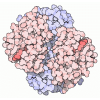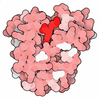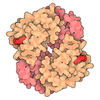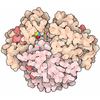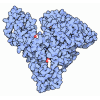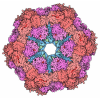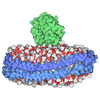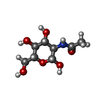+ Open data
Open data
- Basic information
Basic information
| Entry | Database: PDB / ID: 9arv | ||||||
|---|---|---|---|---|---|---|---|
| Title | CryoEM structure of AMETA-A3 | ||||||
 Components Components |
| ||||||
 Keywords Keywords | IMMUNE SYSTEM / IgM / nanobody | ||||||
| Function / homology |  Function and homology information Function and homology informationhexameric IgM immunoglobulin complex / dimeric IgA immunoglobulin complex / IgM B cell receptor complex / secretory dimeric IgA immunoglobulin complex / monomeric IgA immunoglobulin complex / pentameric IgM immunoglobulin complex / secretory IgA immunoglobulin complex / IgA binding / pre-B cell allelic exclusion / IgM immunoglobulin complex ...hexameric IgM immunoglobulin complex / dimeric IgA immunoglobulin complex / IgM B cell receptor complex / secretory dimeric IgA immunoglobulin complex / monomeric IgA immunoglobulin complex / pentameric IgM immunoglobulin complex / secretory IgA immunoglobulin complex / IgA binding / pre-B cell allelic exclusion / IgM immunoglobulin complex / glomerular filtration / CD22 mediated BCR regulation / immunoglobulin receptor binding / positive regulation of respiratory burst / humoral immune response / Scavenging of heme from plasma / antigen binding / Antigen activates B Cell Receptor (BCR) leading to generation of second messengers / Cell surface interactions at the vascular wall / B cell receptor signaling pathway / antibacterial humoral response / protein-containing complex assembly / protein-macromolecule adaptor activity / blood microparticle / defense response to Gram-negative bacterium / Potential therapeutics for SARS / adaptive immune response / immune response / innate immune response / cell surface / protein homodimerization activity / extracellular space / extracellular exosome / extracellular region / plasma membrane Similarity search - Function | ||||||
| Biological species |  Homo sapiens (human) Homo sapiens (human) | ||||||
| Method | ELECTRON MICROSCOPY / single particle reconstruction / cryo EM / Resolution: 3.6 Å | ||||||
 Authors Authors | Huang, W. / Sang, Z. / Taylor, D. | ||||||
| Funding support |  United States, 1items United States, 1items
| ||||||
 Citation Citation |  Journal: Cell / Year: 2024 Journal: Cell / Year: 2024Title: Adaptive multi-epitope targeting and avidity-enhanced nanobody platform for ultrapotent, durable antiviral therapy. Authors: Yufei Xiang / Jialu Xu / Briana L McGovern / Anna Ranzenigo / Wei Huang / Zhe Sang / Juan Shen / Randy Diaz-Tapia / Ngoc Dung Pham / Abraham J P Teunissen / M Luis Rodriguez / Jared Benjamin ...Authors: Yufei Xiang / Jialu Xu / Briana L McGovern / Anna Ranzenigo / Wei Huang / Zhe Sang / Juan Shen / Randy Diaz-Tapia / Ngoc Dung Pham / Abraham J P Teunissen / M Luis Rodriguez / Jared Benjamin / Derek J Taylor / Mandy M T van Leent / Kris M White / Adolfo García-Sastre / Peijun Zhang / Yi Shi /   Abstract: Pathogens constantly evolve and can develop mutations that evade host immunity and treatment. Addressing these escape mechanisms requires targeting evolutionarily conserved vulnerabilities, as ...Pathogens constantly evolve and can develop mutations that evade host immunity and treatment. Addressing these escape mechanisms requires targeting evolutionarily conserved vulnerabilities, as mutations in these regions often impose fitness costs. We introduce adaptive multi-epitope targeting with enhanced avidity (AMETA), a modular and multivalent nanobody platform that conjugates potent bispecific nanobodies to a human immunoglobulin M (IgM) scaffold. AMETA can display 20+ nanobodies, enabling superior avidity binding to multiple conserved and neutralizing epitopes. By leveraging multi-epitope SARS-CoV-2 nanobodies and structure-guided design, AMETA constructs exponentially enhance antiviral potency, surpassing monomeric nanobodies by over a million-fold. These constructs demonstrate ultrapotent, broad, and durable efficacy against pathogenic sarbecoviruses, including Omicron sublineages, with robust preclinical results. Structural analysis through cryoelectron microscopy and modeling has uncovered multiple antiviral mechanisms within a single construct. At picomolar to nanomolar concentrations, AMETA efficiently induces inter-spike and inter-virus cross-linking, promoting spike post-fusion and striking viral disarmament. AMETA's modularity enables rapid, cost-effective production and adaptation to evolving pathogens. | ||||||
| History |
|
- Structure visualization
Structure visualization
| Structure viewer | Molecule:  Molmil Molmil Jmol/JSmol Jmol/JSmol |
|---|
- Downloads & links
Downloads & links
- Download
Download
| PDBx/mmCIF format |  9arv.cif.gz 9arv.cif.gz | 923.7 KB | Display |  PDBx/mmCIF format PDBx/mmCIF format |
|---|---|---|---|---|
| PDB format |  pdb9arv.ent.gz pdb9arv.ent.gz | 644.5 KB | Display |  PDB format PDB format |
| PDBx/mmJSON format |  9arv.json.gz 9arv.json.gz | Tree view |  PDBx/mmJSON format PDBx/mmJSON format | |
| Others |  Other downloads Other downloads |
-Validation report
| Summary document |  9arv_validation.pdf.gz 9arv_validation.pdf.gz | 1.3 MB | Display |  wwPDB validaton report wwPDB validaton report |
|---|---|---|---|---|
| Full document |  9arv_full_validation.pdf.gz 9arv_full_validation.pdf.gz | 1.3 MB | Display | |
| Data in XML |  9arv_validation.xml.gz 9arv_validation.xml.gz | 71.4 KB | Display | |
| Data in CIF |  9arv_validation.cif.gz 9arv_validation.cif.gz | 108.3 KB | Display | |
| Arichive directory |  https://data.pdbj.org/pub/pdb/validation_reports/ar/9arv https://data.pdbj.org/pub/pdb/validation_reports/ar/9arv ftp://data.pdbj.org/pub/pdb/validation_reports/ar/9arv ftp://data.pdbj.org/pub/pdb/validation_reports/ar/9arv | HTTPS FTP |
-Related structure data
| Related structure data |  43795MC M: map data used to model this data C: citing same article ( |
|---|---|
| Similar structure data | Similarity search - Function & homology  F&H Search F&H Search |
- Links
Links
- Assembly
Assembly
| Deposited unit | 
|
|---|---|
| 1 |
|
- Components
Components
| #1: Protein | Mass: 41152.266 Da / Num. of mol.: 10 Source method: isolated from a genetically manipulated source Source: (gene. exp.)  Homo sapiens (human) / Gene: IGHM / Production host: Homo sapiens (human) / Gene: IGHM / Production host:  Homo sapiens (human) / References: UniProt: P01871 Homo sapiens (human) / References: UniProt: P01871#2: Protein | | Mass: 19225.762 Da / Num. of mol.: 1 Source method: isolated from a genetically manipulated source Source: (gene. exp.)  Homo sapiens (human) / Gene: JCHAIN, IGCJ, IGJ / Production host: Homo sapiens (human) / Gene: JCHAIN, IGCJ, IGJ / Production host:  Homo sapiens (human) / References: UniProt: P01591 Homo sapiens (human) / References: UniProt: P01591#3: Sugar | ChemComp-NAG / Has ligand of interest | N | Has protein modification | Y | |
|---|
-Experimental details
-Experiment
| Experiment | Method: ELECTRON MICROSCOPY |
|---|---|
| EM experiment | Aggregation state: PARTICLE / 3D reconstruction method: single particle reconstruction |
- Sample preparation
Sample preparation
| Component | Name: Adaptive Multi-Epitope Targeting and Avidity-Enhanced (AMETA) Nanobody Platform Type: COMPLEX / Entity ID: #1-#2 / Source: RECOMBINANT |
|---|---|
| Source (natural) | Organism:  Homo sapiens (human) Homo sapiens (human) |
| Source (recombinant) | Organism:  Homo sapiens (human) Homo sapiens (human) |
| Buffer solution | pH: 7.5 |
| Specimen | Embedding applied: NO / Shadowing applied: NO / Staining applied: NO / Vitrification applied: YES |
| Vitrification | Cryogen name: ETHANE |
- Electron microscopy imaging
Electron microscopy imaging
| Experimental equipment |  Model: Titan Krios / Image courtesy: FEI Company |
|---|---|
| Microscopy | Model: FEI TITAN KRIOS |
| Electron gun | Electron source:  FIELD EMISSION GUN / Accelerating voltage: 300 kV / Illumination mode: FLOOD BEAM FIELD EMISSION GUN / Accelerating voltage: 300 kV / Illumination mode: FLOOD BEAM |
| Electron lens | Mode: BRIGHT FIELD / Nominal defocus max: 2500 nm / Nominal defocus min: 500 nm |
| Image recording | Electron dose: 34 e/Å2 / Film or detector model: GATAN K3 BIOCONTINUUM (6k x 4k) |
- Processing
Processing
| EM software | Name: PHENIX / Version: 1.21rc1_5015 / Category: model refinement | ||||||||||||||||||||||||
|---|---|---|---|---|---|---|---|---|---|---|---|---|---|---|---|---|---|---|---|---|---|---|---|---|---|
| CTF correction | Type: NONE | ||||||||||||||||||||||||
| 3D reconstruction | Resolution: 3.6 Å / Resolution method: FSC 0.143 CUT-OFF / Num. of particles: 233181 / Symmetry type: POINT | ||||||||||||||||||||||||
| Refinement | Cross valid method: NONE Stereochemistry target values: GeoStd + Monomer Library + CDL v1.2 | ||||||||||||||||||||||||
| Displacement parameters | Biso mean: 190.48 Å2 | ||||||||||||||||||||||||
| Refine LS restraints |
|
 Movie
Movie Controller
Controller



 PDBj
PDBj

